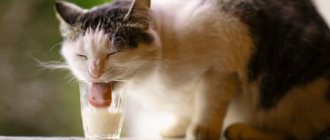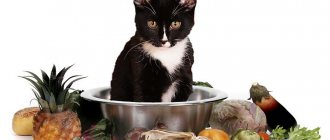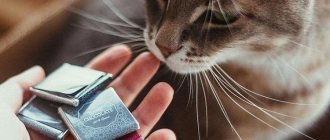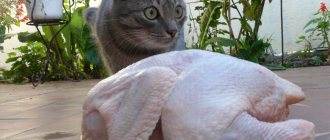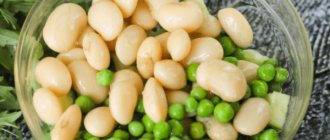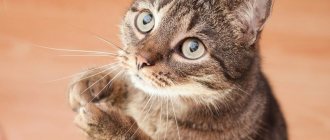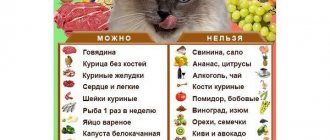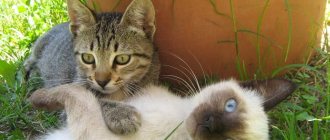The role of grains in the diet
If we consider the chemical composition of cereals, then, of course, each cereal is rich in certain vitamins, minerals, and fiber, which are very useful and necessary in the animal’s diet. For the owners, the indisputable advantage is the low cost and ease of preparation of such dishes.
However, do not forget that cereals are a source of complex carbohydrates. And since cats by their nature are not very active (they spend about 80% of their time sleeping), frequent consumption of porridge can lead to obesity and other associated pathologies.
A cat is a predator. Under natural conditions, she does not eat grains, so her body is not configured to digest coarse fiber. Excessive consumption of the product can lead to changes in the microflora in the intestines, followed by dysbiosis, decreased immunity and other disorders.
But you also can’t do without porridges, because they stimulate intestinal motility and help cleanse the body. The optimal proportion of grains in the general diet is 20% (2-3 meals per week). A larger amount of product is no longer desirable for a furry pet.
Frequency of feeding the animal with cereals
How many days before vaccination should a cat be given anthelmintic?
After you have figured out which grains can be given to cats and which cannot, you need to understand how often it is given to your pet. If you do not adhere to certain dietary rules, then even the most harmless porridge can create many problems for the body.
Here's what you need to know:
- Porridge is allowed to be given no more than twice a week. This will be enough to take the required amount of vitamins and beneficial microelements from the cereals.
- If the animal is bottle-fed, it is prohibited to give cereal and dry food at the same time. The minimum gap between meals should be at least 6 hours.
- You cannot suddenly switch an animal from one type of food to another; this must be done gradually and in small portions.
- If you need to switch your cat to diet food for health reasons, then you should add meat, fish and vegetables to the porridge to saturate the natural food with nutrients.
- Pregnant and lactating cats need to boil porridge with milk as much as possible. This makes them easier and faster to digest.
- Milk porridge should not be given to kittens after one year. They need to be switched to porridge with meat, fish or vegetables.
- There should be the largest amount of offal in the diet, a little less porridge, it is also important to include greens, fats and vitamins.
- It is forbidden to put various seasonings in porridge, only salt in small quantities.
Proper nutrition is the key to a healthy pet
Healthy cereals
Porridge is useful for cats because it is easily and quickly digested without overloading the digestive system. These include the following types of cereals:
Oatmeal
This is the healthiest product of all cereals, containing many vitamins and mineral salts. Fiber from oat bran is easily absorbed by the body and acts as a “brush” for the intestines, so it should be included in your cat’s diet. In addition, oatmeal is the only porridge that is equally beneficial for both small kittens and adult pets.
Some owners mix oatmeal with ready-made food to improve the taste, but experienced breeders advise combining porridge cooked in water with pieces of boiled meat, such as chicken, and vegetables. If you cook it with milk, you get the perfect porridge for a small kitten who needs more calories. For a child with a gluten allergy, prepare rolled oats - it contains less of this component.
Rice
Can domestic cats have rice? This question is quite relevant, since it is believed that digesting rice takes a lot of time. In fact, rice cereal is very healthy for cats.
They stabilize digestion, contain many vitamins and carbohydrates, and are not too high in calories. Experts recommend giving cats unpolished rice, which contains more nutrients. It is better to cook it in meat broth and mix it with meat or vegetables when serving.
Buckwheat
Buckwheat is considered one of the most popular and healthy cereals in a cat’s diet. It contains a lot of carbohydrates, proteins, which are easily converted into energy, and fiber. In addition, cereal contains a lot of calcium and iron, which is important for the full development of kittens. For a small pet, porridge can be prepared with milk with the addition of butter; for an adult, a dish with broth is more suitable.
Pearl barley
Barley is no less useful for cats. It does not cause allergies, does an excellent job of cleansing the intestines and contains many useful substances: vitamins (D, A, group B), microelements and essential amino acids. It is better to cook pearl barley porridge in broth and serve it with pieces of meat, fish or vegetables. The only inconvenience is that the barley needs to be soaked before cooking, but even after that it takes quite a long time to cook.
Should you feed your cat porridge or should you abstain?
You can give your pet certain cereals (not prepared with milk), mixing them with meat, canned cat food or dry food. If your animal likes porridge without additives, you should not overuse it - you should always make sure that the cat does not receive more carbohydrates than it needs.
Many pets are happy to eat porridge without additives
Cereals and cereals will help add a number of useful substances to your pet’s diet and, to a certain extent, reduce the cost of keeping a cat without harming it. Not sure which porridge to choose? Entrust the decision to your pet - most often the cat’s body itself knows what it lacks in nutrition, and the animal chooses the healthiest food from all possible options. Offer your cat several approved cereals and cook the one she likes.
It's better not to feed
All so-called “instant” cereals are forbidden for cats, since they contain a lot of sugar - the most harmful product for a cat’s stomach, as well as cereals that are simply not absorbed by the animal’s body.
Semolina
Many owners are sure that semolina with milk is necessary for the growing body, so they often treat their pets to such porridge. They continue to feed an adult cat this product, adding meat or fish to it, which causes irreparable harm to the animal’s body. Numerous studies have proven that semolina is pure starch, which does not provide any benefit. In addition, it contains a lot of gluten, which makes the product too heavy and takes a long time to digest.
Millet
Another harmful and heavy grain is millet. Even when cooked in water, it is quite high in calories and is practically not absorbed by the cat’s body.
Corn porridge
Corn grits contain many microelements and vitamins, but they are absolutely not suitable for regular feeding of cats. Veterinarians claim that 90% of digestive problems are caused by this porridge, since it is not only poorly digested, but also causes flatulence and constipation.
What to do if the cat does not eat porridge?
It is easy to persuade your pet to eat porridge if you add pieces of meat. It should be boiled. You should choose lean varieties. When the pet refuses to eat such a dish, a little wet cat food or crushed dry food is added to it.
Be sure to read:
Spiders for cats: what they are, composition, types, better canned food, how to choose, pros and cons
At first, the animal may not eat the prepared food completely, but, gradually getting used to it, it will eat fully. Feeding porridge should be regular.
Barley porridge for cats with grated carrots and turkey breast
Cook barley (2 cups) as usual, but without salt. The cooking process can be speeded up by soaking the grains a day before. Cut the turkey into small cubes, put it in a bag and put it in the freezer. To prevent the pieces from sticking to each other, the bag must be shaken periodically. Take a small carrot, peel it and grate it.
Now take 4 tbsp. porridge, 1 tsp. grated carrots, 2 tbsp. turkey, scalded with boiling water and mix together. To soften the porridge, add 1 tbsp. boiling water Mix thoroughly and give to the cat. The proportions of barley porridge can be changed at your pet’s discretion.
Correct selection of diet
- Surely every cat owner knows how much his pet, due to its natural characteristics, is classified as a predatory mammal. This is true even if we are talking about domesticated pets. The basis of the basic diet is fish and meat; about 60% and even more are allocated to them. The choice is given to beef, turkey, chicken and other low-fat varieties.
- It is forbidden to treat your pet to a raw meat product. It needs to be scalded, and again better – boiled. It would also be a good idea to grind it into filling or finely chop it. If the animal does not like boiled food (plural), then the meat is first thoroughly frozen, then defrosted and scalded with boiling water. This way) partially eliminates the possibility of helminth infection.
- It’s worth remembering why your four-legged friend’s diet (about 60%) will include meat. Otherwise, give your animal a variety of vegetables. Such products are simply necessary for the body, even for predatory individuals. They contain a very valuable composition, thanks to which internal organs can still function fully. Animals also need a vitamin complex.
- In addition to vegetables, be sure to include a variety of cereals in your daily diet. From here we can conclude that it is completely forbidden to feed your pet rice. But remember that a small percentage is allocated to cereals. Therefore, give rice in small quantities. Be sure to alternate porridges between each other.
- It is best to include rice in the animal's menu 1 maximum element 2 times a week. Remember about additional vitamin supplements. Include such complexes in your soldering regularly. To ensure that the animal feels great and always has excellent hygiene, take care of it. It will tell you what is better to choose.
- It is important to select vitamin complexes based on the characteristics of your four-legged friend’s body. Without visiting a veterinarian. The specialist must examine the animal and, if necessary, perform tests. Breed also plays an important role. Therefore, after all tests, the correct vitamins are prescribed.
What kind of cereals can you give?
Porridges that are easily digestible are suitable for consumption. They are a source of essential minerals and help improve immunity.
Rice
It is considered the most beneficial for cats. It contains a large number of useful substances. Rice porridge helps improve digestion and stool frequency. Regular consumption is good for the heart and nervous system. Well suited for cats with allergies: it is gluten-free.
Buckwheat
Very nutritious and easily digestible. Contains a lot of proteins, carbohydrates, fiber, iron and calcium. Positively affects the formation of pet bones. Buckwheat porridge normalizes digestion and pancreas function.
Oatmeal
Rich in various vitamins and carbohydrates: calcium, magnesium, sodium, phosphorus, zinc. Contains biotin, which prevents the development of skin diseases. Oatmeal stimulates metabolism and helps remove toxins and harmful substances from the cat’s body.
Pearl barley
Has an “antibacterial” effect on the body. Contains many useful vitamins and amino acids. Improves the functioning of the digestive system and intestines in pets, therefore it is useful for animals with these problems. Prevents the development of allergies.
Cooking rice for your pet
Any cereal, and rice is no exception, can be given to pets only in boiled form:
- Rice porridge is boiled in water and then other ingredients are added to it. These can be pieces of boiled or scalded meat (chicken, turkey, rabbit, veal). It is also allowed to introduce offal: boiled chicken hearts, gizzards, beef heart or others. In addition, vegetables (carrots, zucchini, pumpkin, broccoli) - fresh chopped, boiled or steamed - will be an excellent addition. Fresh finely chopped greens will enhance the taste of the dish.
- Cat food is prepared without sauces, gravies, spices or other additives. Salt, caustic vegetables - onions, garlic and spices - are toxic to the cat's body and will only cause harm to it.
- In a mixed dish, the share of cereals is no more than a quarter of the total volume. If rice porridge is given without other products, then a single serving is approximately ¼ of a cup.
- Among the variety of varieties and types of rice, brown, unpolished rice is considered the most useful. But your pet will receive minimal benefits from polished white or steamed cereals. In addition, this grain has increased starchiness. But if you ask the cat herself, she will choose a more tasty product - white, polished rice.
The nuances of feeding cereals.
You should not give your pet a large amount of rice, even boiled, as it has a fixing effect. These foods can cause constipation in your cat.
Is rice safe for cats?
Gastrointestinal disorders among our little brothers are, alas, not uncommon. A sick animal needs a special therapeutic diet. As a rule, veterinarians prescribe non-concentrated and unsalted chicken broth, chicken pieces and boiled cereal. This recipe is probably suitable for dogs. But now we’ll find out the question: can cats be given rice?
